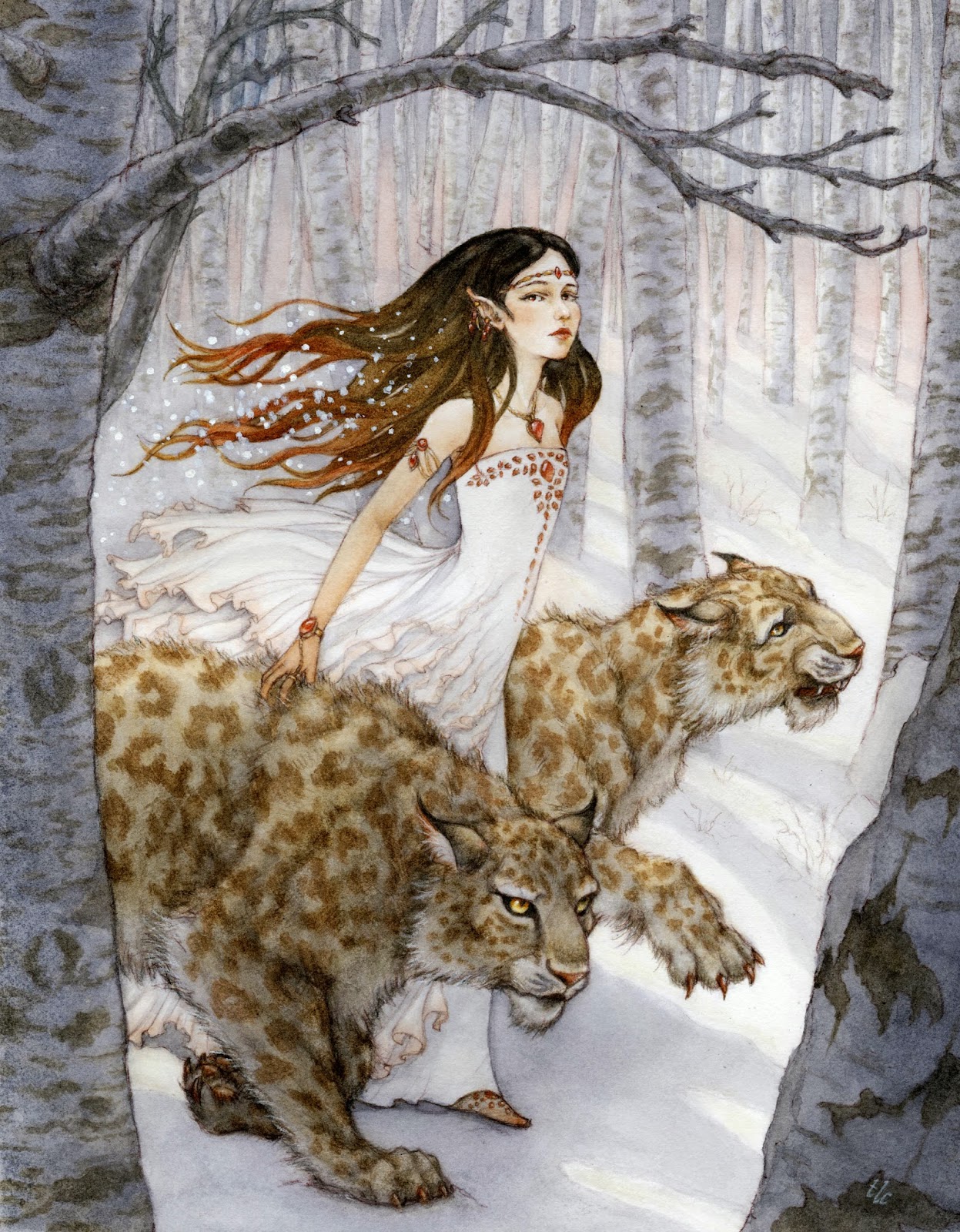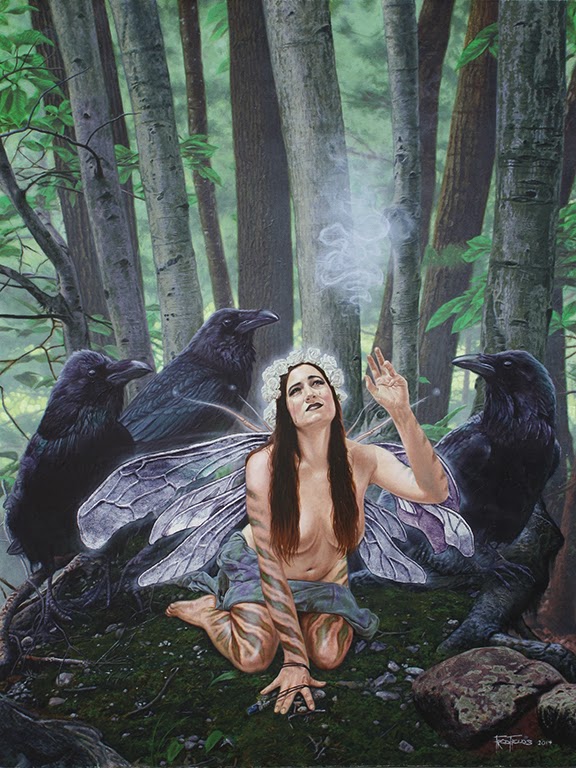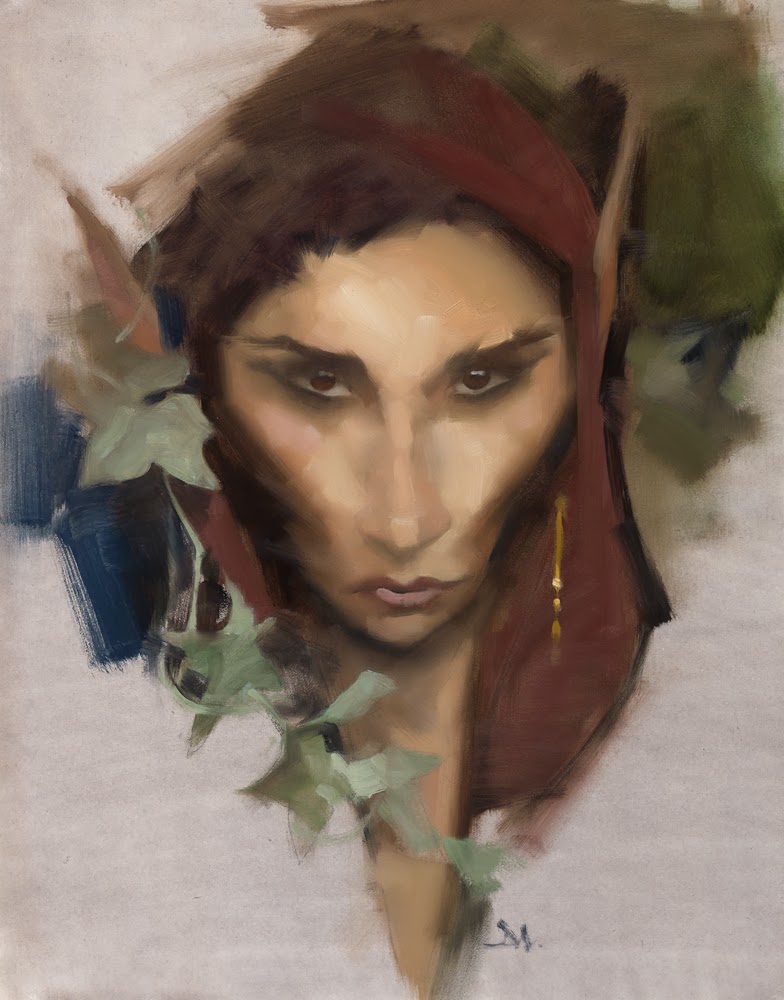I'm going to need to backtrack a little over a year, when fellow Krab Jabber, painter Kyle Abernethy, introduced me to the woman who ran
TLC Workshops, an illustrator named Tara Larsen Chang. I myself ran a couple of workshops at Krab Jab Studio and marveled at the success of this relatively new workshop machine that booked talent such as Greg Spalenka, Brom, and Terese Nielsen, among others. Honestly, I was a bit irked; I mean, she was making my job of putting "butts in seats" fifty times harder! Plus, Kyle had gotten into her Brom workshop and couldn't stop blathering over how great the facility and experience was. He insisted we meet.
The woman he introduced me to was truly magical. Smiling, warm, talking a mile a minute, Tara was instantly likeable. She was a Doer, a Seeker, and a Dreamer. All my envious feelings melted away when I realized that much like me she worked hard in the background of her workshop machine, and much like me, she was a huge fan of the artists (and students) she supported. And... she was a faerie artist.
 |
| Tara Larsen Chang |
Not only was Tara a faerie artist, but she was connected to many of the faerie artists I admired and had worked with in the past. I mentioned my idea of a Faerie show, and she enthusiastically offered to help me cull together one of the most interesting and beautiful group shows we've done, which debuted with glowing reviews in February 2013. Not only were the "old favorites" of Amy Brown and the Frouds (including Toby Froud), but newer talent such as Emily Fiegenschuh, Yoann Lossel and David Thierree were introduced to Seattle. Without Tara's help I would not have gotten in touch with Robert Gould, the mastermind behind
Faerieworlds and another enthusiastic backer of the FAERIE show. Before the show even closed, Tara and I were already concocting plans for FAERIE II.
 |
| Amy Brown |
So here we are, a year later, and FAERIE II will be opening in just a few days. I asked Tara to be guest curator this time, and she eagerly accepted and went to work on her list of invites. The list was long - too long, actually. There are a lot of great faerie artists out there, but the gallery can only stuff so much into it. We had to cut a few people out (many of which are highly talented, by the way. I was also cut, so this wasn't necessarily biased). Tara came up with a stunning list of artists, and happily, nearly all of them accepted the invitation to show. As Tara states: "When considering who to invite to participate in this assemblage, I thought of those artists whose fairy art I was familiar with and admired. Many of them are well known and the others should be! It's a striking assortment of talent."
 |
| Kimberly Kincaid |
We worked alongside Robert Gould, as he loved the idea of a Faerie exhibition in his February convention, aptly called
FaerieCon West (located in the Seattle-Tacoma area - see website for details, it's a pretty wonderful event). FAERIE II will exhibit in it's own room at the convention February 21-23, with many of the attending guest artists on the exhibit roster.
 |
| Linda Ravenscroft |
Okay, fairies... what's the big deal? For me, Disney kind of ruined them. Disney and all those well-meaning "house fairy" sculptures and badly painted watercolor greeting cards, the cutesy little kid fairies with impossibly tiny insect wings. Faerie and the Fae was reduced to kitschy, cutesy and completely harmless. Scared of a fairy? Really???
 |
| Annie Stegg |
Really. The Realm of Faerie was not always filled with tiny butterfly children and impish smiling elves hiding under mushrooms. It was a spiritual world of Nature, an otherworld that was both marvelous and tempestuous. It wasn't hard to accidentally piss a fairy off, and they often stole milk, cows, or children from their human neighbors. While there were faerie folk of small stature, depending on the region where one lived, they could be human sized or larger, or simply blinking balls of light. Sometimes they married and lived alongside humans, but mostly they kept to themselves, dancing in the moonlight, always enjoying what Nature offered in their magical realm. Until they were squelched from everyday life (thanks to the Church) and reduced to children's stories, they were feared, loved, and most of all, respected. Many believed the Fae were the spirits of our Natural world, and often one would see a dearly loved one, passed on, dancing alongside the Fae in the tall grasses and sacred groves, smiling and laughing, young and vibrant.
 |
| Fred Fields |
I believe that thanks to Brian Froud and his friend Alan Lee, the world of Faerie began to take on it's original face with the general public. They published the now-iconic book,
Faeries, igniting a new interest in the old beliefs of the Celtic regions of Ireland, Scotland, England, Wales and Brittany. Their beautiful illustrations of the world of Fae opened the door to many similar artists, and once again did the Faerie demand her rightful respect. The fairy was now the Faery, both beautiful and terrifying, generous and mischievous, mysterious and strangely familiar.
 |
| Greg Manchess |
The Fae take on many shapes and forms. Terra-bound and aquatic, tiny and huge, red-capped and finely dressed or completely nude, wings or simply radiating, faeries and their ilk run the imaginary gamut of form and function. Many faerie artists find a form they enjoy working with, and some of them like to push the envelope into pure weirdness. Allen Williams, for example, works smokey, ghostly forms into his graphite masterpieces, with bony, spurred horns emerging from the tops of heads and tree trunks. The Fae manifest through the artist's hand in the forms they choose. Allen may think he has a handle on them, but truly it's the other way around.
 |
| Allen Williams |
When speaking with Tara about the lure of Faerie, she puts it this way: "I think there is more 'out there' than what generally meets the eye. What *is* however, is harder to define or quantify. I believe things like fascination-with-the-fae begin to attempt to give form to the mystery of the unknown."
 |
| Justin Gerard |
From the point of the artist, Tara adds: "To me, a large aspect of Faery is Nature and her forces personified. Something that can be both intensely appealing and deeply perilous to interact with. As part of the unseen natural world, their mien reflects the many facets of organic beauty and wild unpredictability. To depict them effectively, I believe one must portray these paradoxical elements that make them enigmatic and ultimately unknowable."
 |
| Stephanie Pui-Mun Law |
Faeries can also be humorous; who better to depict this than Brian Froud? His 1994 book,
Lady Cottington's Pressed Fairy Book, exemplifies this to a T. The squashed fairies in this album are often in silly positions, smiling, tongues sticking out. (no real faeries were harmed in the making of this book)
 |
| Brian Froud |
With 24 stellar artists in this exhibit, I can't realistically show every one of them in this blog post; you'll have to visit the show itself or view the
full catalog, available online February 9th until show ends February 27th. When I asked Tara what she hoped the viewer would take away from this show, she stated: "I hope the viewers of this collection get a glimpse into the realm just beyond the senses, and go home with an increased sense of wonder and mystery."
Reception is February 8th, 6 - 9 pm, show runs through February 27th. All works are original and for purchase. Select prints also for sale. Exhibition will travel to FaerieCon West February 21-23rd. We'd also like to thank our NYC support, the
AFA Gallery, who represent the Froud family and exclusively consign their art to Krab Jab Studio.
If you'd like to read what the artists have to say about their work, make sure to check out the online catalog!
 |
| Gary Lippincott |
-Julie Baroh, February 2014












Great post, Julie. I'm so excited to be apart of this exhibit. Just wish I could be there.
ReplyDeleteThanks, I wish you could be too! :-)
ReplyDelete